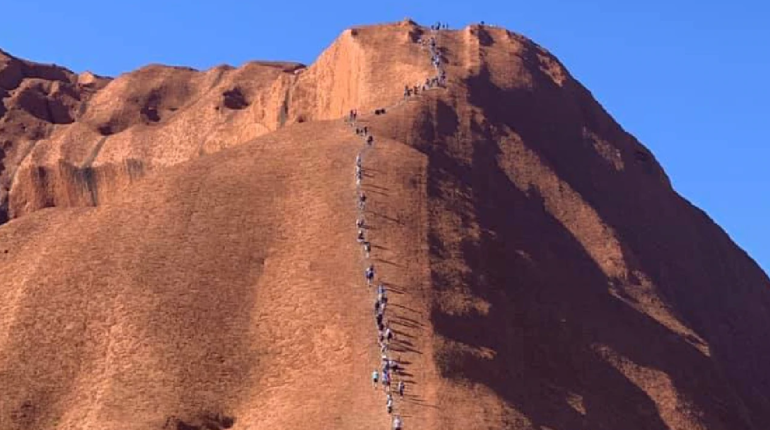Sponsored Listings:
Hordes of tourists are descending on Uluru to climb it before it closes — wreaking havoc.
A photo taken at the base of Uluru on Wednesday showed a queue snaking up to the top of the rock, as hundreds arrive daily before the ban on climbing comes into effect on October 26.
The Anangu traditional landowners and Alice Springs locals say tourists are leaving rubbish bins overflowing, illegally dumping human waste from caravans along the roadside, and have made Uluru-Kata Tjuta National Park the “busiest they’ve seen it”.
“There are cars parked for one kilometre on either side of the road leading up to the carpark at the base,” an unnamed photographer who supplied the photo to ABC Alice Springs said.
About 140 people were ascending the rock each day when the decision to ban the climb was made in 2017, but that number has skyrocketed to between 300 and 500 people as the climb ban approaches.
Stephen Schwer, chief executive of Tourism Central Australia, told the ABC tourists were also trespassing, camping illegally and dumping rubbish on private lands.
“(Tourists) think they’re doing a good thing by free camping along the way; what they are actually doing is trespassing on pastoralist and joint-managed and protected land, and a lot of people don’t seem to be getting that message,” Mr Schwer said.
“When there is the kind of influx of drive travel as we are seeing at the moment, there is an influx of waste.”

Lindy Severin, the owner of Curtin Springs station about 100 kilometres from Uluru, said thousands travelling in caravans had been dumping their toilet tanks on the roads.
“There are limited areas to dispose of black waste in Central Australia — it’s either Alice or Ayers Rock near here — and we’ve got visitors who don’t want to stand in queues to dump waste,” Ms Severin told the ABC.
“There’s just rubbish everywhere, (including) used toilet paper.”

Traditional landowners are devastated by the masses rushing to climb Uluru before the cut-off date despite it long being common knowledge the act is deeply offensive.
“It makes me sick looking at this photo at the disrespect and disregard shown for the traditional owners’ wishes,” said a spokesperson from the Darug Custodian Aboriginal Corporation.
“Not only do people climb it but they defecate, urinate and discard nappies and rubbish on it.
“I for one cannot wait for the climb to be permanently closed and our sacred lore, culture and traditions to be acknowledged and respected.”
The influx of tourists to the famous red monolith is reminiscent of the “human traffic jam” that clogged Mt Everest this year, resulting in at least 11 deaths and tonnes of garbage left behind.
ULURU IS ‘NOT DISNEYLAND’
The Uluru-Kata Tjuta National Park Board announced in 2017 that tourists would be banned from climbing the rock on October 26, 2019.
The announcement came after it was found that less than 20 per cent of people visiting the park were making the climb, down from more than 70 per cent in previous decades.
Uluru, or Ayers Rock, is sacred to indigenous Australians and thought to have started forming about 550 million years ago.
The climb was always discouraged by the park’s traditional owners, the Anangu people, as it was deemed disrespectful due to the sacred nature of the area.
The climb has also damaged the rock itself, with a huge white scar from tourists walking the same path being visible from a distance.
A sign sits at the base of the climb, imploring visitors to reconsider their need to scale the rock.
“We, the traditional Anangu owners have this to say,” the sign reads.
“The climb is not prohibited but we ask you to respect our law and culture by not climbing Uluru. We have a responsibility to teach and safeguard visitors to our land. The climb can be dangerous. Too many people have died while attempting to climb Uluru.”
At least 35 people have died while attempting to climb Uluru, and many others have been injured.
From 2011 to 2015, the climb was closed 77 per cent of the time due to dangerous weather conditions or cultural reasons.

A 12-person board voted unanimously to close the rock on a very symbolic date — the 34-year anniversary of the day the Uluru land title was handed back to the Anangu people.
Chairman and senior traditional owner Sammy Wilson made an impassioned speech prior to the vote, explaining the sacred nature of the site.
“It is an extremely important place, not a playground or theme park like Disneyland,” he said. “If I travel to another country and there is a sacred site, an area of restricted access, I don’t enter or climb it, I respect it. It is the same here for Anangu. We welcome tourists here. We are not stopping tourism, just this activity.”
Mr Wilson ended his address with a call for unity.
“The land has law and culture. We welcome tourists here. Closing the climb is not something to feel upset about but a cause for celebration. Let’s come together; let’s close it together,” he said.
Visitors to Uluru-Kata Tjuta National Park will still be able to walk around the base, take a cultural tour or a dot-painting workshop.
Announcing the decision in 2017, National Parks director Sally Barnes said: “This is a significant moment for all Australians and marks a new chapter in our history. It clearly says we put country and culture first when managing this place for all Australians and our visitors from around the world.”
Source: nzherald.co.nz










